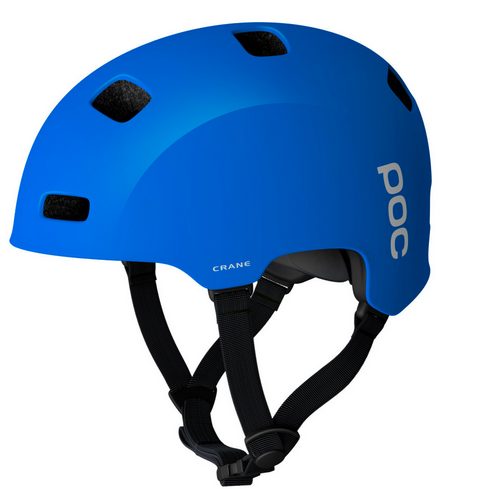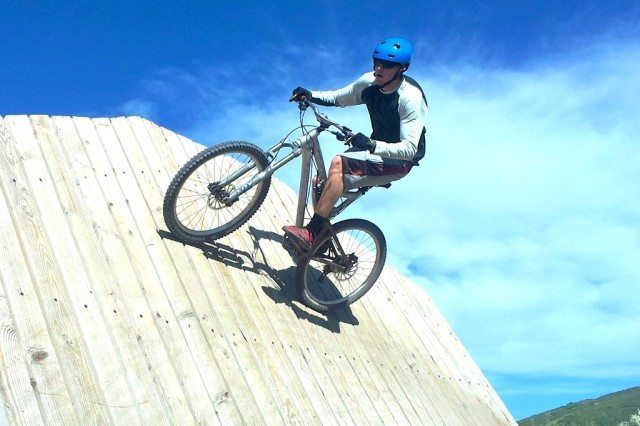POC Crane Helmet
Size: M/L (56-59 cm)

Reviewer’s Head Circumference: 56.75 cm
Intended Use: Urban / Park / DJ / Freeride / Enduro
Stated Weight: 360-400 grams
BLISTER’s Measured Weight: 398 grams (M/L)
Technical Features (from POC):
- Progressive core, dual density EPS liner
- Size-adjustment system
- Ventilation slots
- Straps molded inside the liner
Certifications: CE EN 1078, CPSC 12.03, AS/NZS2063-2008
Duration of Test: Used intermittently for 4 months
Test Locations: Salt Lake City, Park City, Utah
MSRP: $120.00
When it comes to helmets, there’s an important caveat that must be stated, and I can’t say it any better than fellow reviewer Noah Bodman did in his write-up on the POC Cortex Flow:
“First things first: this is a helmet review, and a helmet won’t do what it’s supposed to unless it fits you right. Different helmets and different companies’ molds fit differently, and everyone’s head is a little different. If the POC doesn’t fit you correctly, the rest of this review is pretty much irrelevant. (Check out the POC website for their sizing guide, which also encourages you to try on gear before purchasing.)”
So with that, on to the POC Crane.
The story I’ve heard about the development of the Crane was that it was originally slated for the urban / commuter type. Freeride and slope athletes were so stoked on the look of the helmet, however, that it started finding its way onto podium stands.
Aside from the low, well-shaped profile, the Crane’s two main functional areas of interest are the thicker in-mold shell and dual density EPS liner.

Fit / Sizing
As I’ve already mentioned, a properly fitting helmet is crucial to protect your head. Considering the intended use of the Crane, a proper fit also keeps the helmet from being annoying—e.g. moving around while you’re experiencing the forces of takeoffs, landings, and tricks.
POC helmets definitely have a unique fit and are only available in three sizes—XS/S; M/L; and XL/XXL. If you’re considering an online purchase and you’ve never worn a POC helmet, I would highly recommend finding one to try on before submitting an order.
I have a fairly narrow head that’s ~56.75 cm in circumference, and I typically wear a size medium helmet. The M/L Crane that I have fits well thanks to the size adjustment system, which adjusts to grab the back and side of your head. With this system comfortably snug, I can actually hang upside down with the helmet on my head unbuckled. I would feel better if there were a bit of foam to take up the dead space between the side of my head and the hard foam of the helmet.

The size adjustment system has two positions at the rear of the helmet so it can be placed optimally just under the occipital bones. Luckily the lower holes worked well for my head since the upper holes on my particular helmet were a little too wide, and therefore unusable.
The chin straps feature a standard, easily-adjustable clip buckle under the chin, and a slide-lock mechanism on each side to adjust the opening around the ears. The straps connect to the helmet with very clean, molded brackets, which keep the straps flat and very comfortable.
Safety
Moving on to the dual density EPS liner, POC claims the “stiffer outer part deals with higher energy impacts while the inside provides protection for lower energy impacts. In combination, the two densities provide a progressive stop in case of impact.” Fortunately for me, and unfortunately for you, I haven’t whacked my head on anything worse than a low branch while wearing the Crane, so I won’t be able to provide much insight into the protective ability of the helmet.
The Crane does meet CPSC, CE EN 1078, and AS/NZS2063-2008 certifications though, so it’s theoretically as good as any other certified helmet out there.
Venting
The Crane features 10 fairly large vents, a luxury not found on many helmets in this category. While riding, the vents do pull heat away from my hot noggin, but on days hotter than 80 degrees I found my head sweltering—most noticeably in the forehead area—when I lapped jump lines.

The foam pad at the front of the helmet runs across my whole forehead, creating a seal of sorts. On most hot outings, I ended up removing the helmet on the walk or the pedal back to the top, as I’ve done with another skate-style inspired helmet I’ve used a lot, the Bern Watts.
Now that temps have cooled significantly, I’ve enjoyed this helmet about every time I’ve used it, from park laps to shuttle rides, and even some XC on those chillier days.
Weight
While there are a number of benefits to in-mold helmets, including their light weight, a major drawback is how easily the typical thin shells dent. The in-mold-constructed Crane avoids this issue by using a comparatively thicker (~1mm) shell, which, according to POC, “makes it 50% more resistant to dents, compared to normal in-mold helmets.”
Weighing in at 398 grams, the Crane is competitive among its peers. When you factor in the added durability of the thicker shell, however, the Crane may have the upper hand.
NEXT PAGE: Durability
